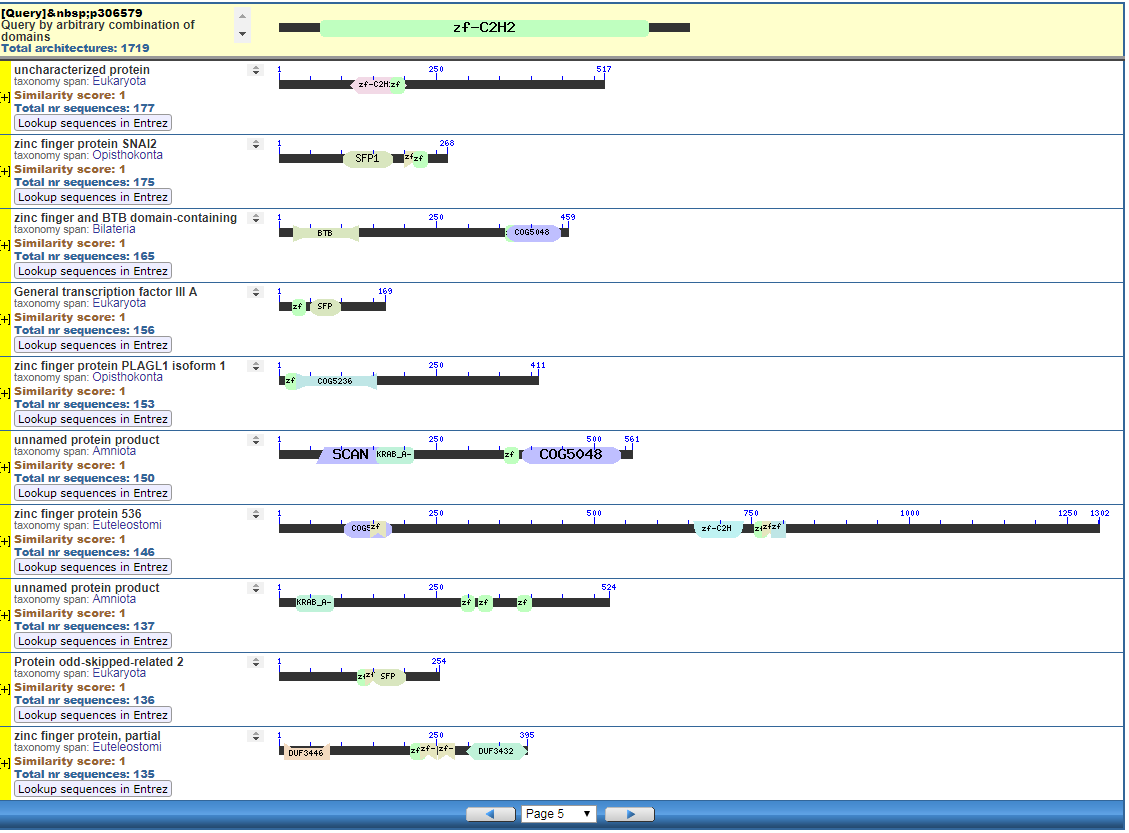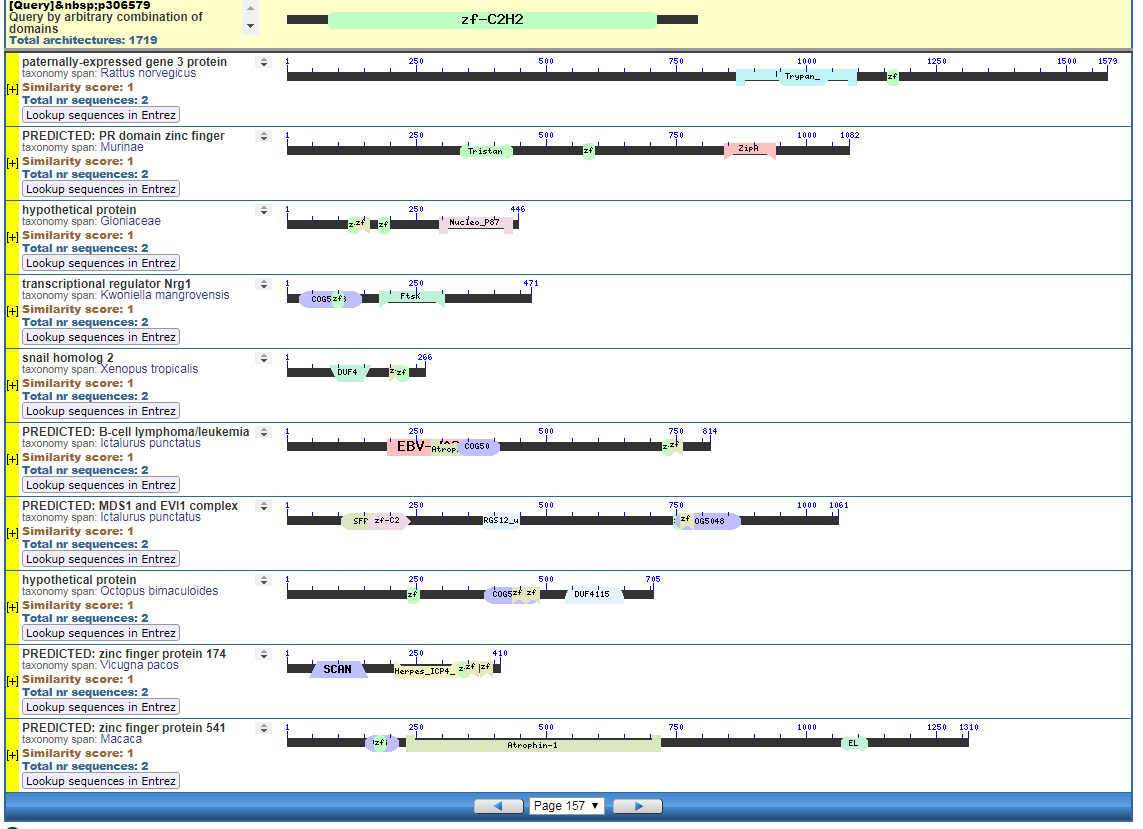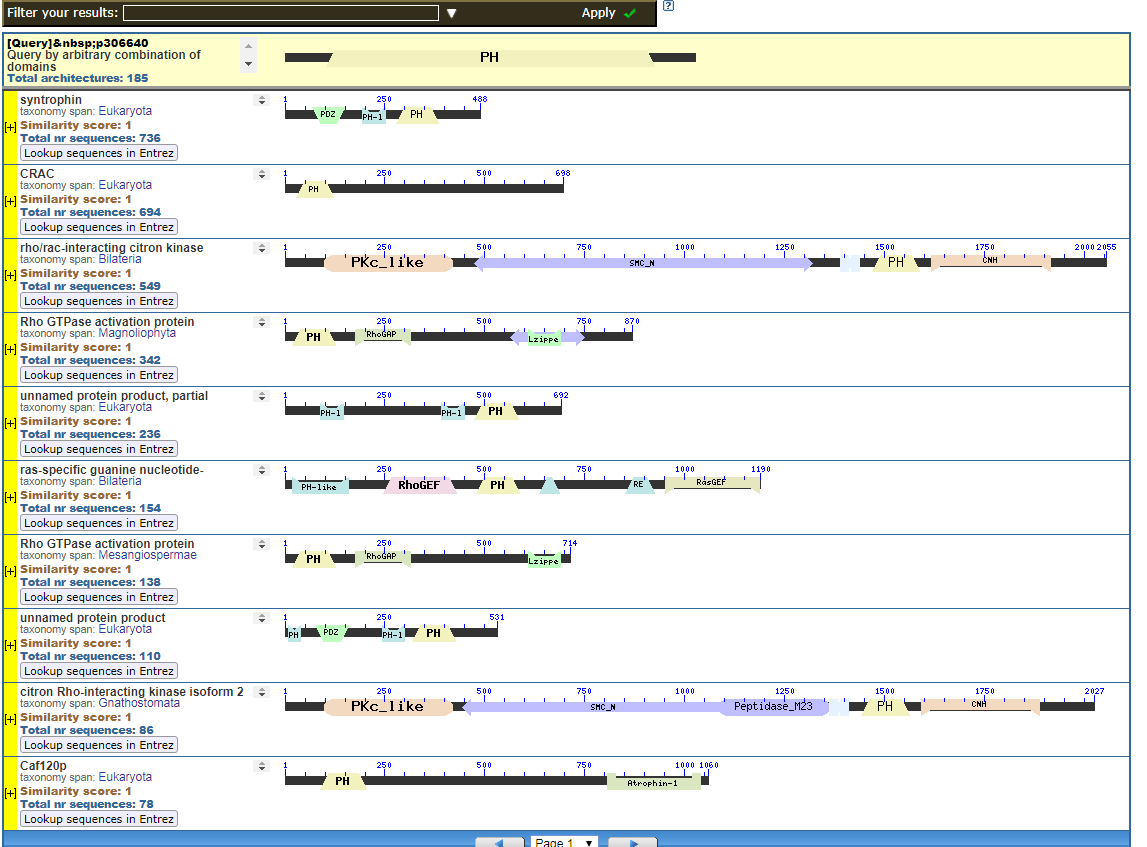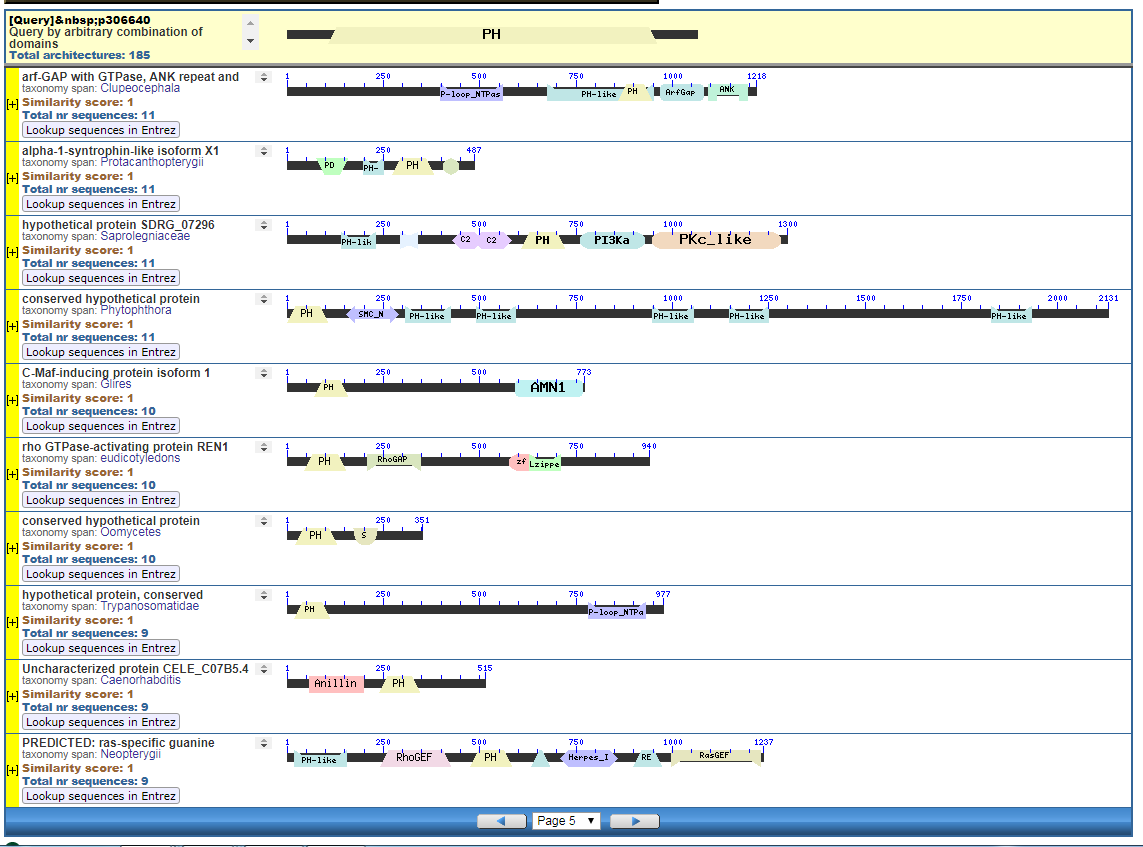Dr. Winston Ewert put forward his module hypothesis, but I put forward an alternate module hypothesis at the domain and motif level of proteins. It is based actually on papers by evolutionists who have pointed out that the problem of “Promiscuous Domains” remains an unsolved problem in evolutionary biology.
When I put Promiscuous Domains on the table in the Common Design vs. Common Descent thread, the TSZ Darwinists ignored the problem and then declared victory. I viewed their non-response as evidence they didn’t understand the problem and/or preferred to ignore it.
Perhaps pictures are worth ten thousand words. From the NIH, that great source inspiration for the Intelligent Design community, we have the CDART database viewer.
From the CDART viewer, I provide a few of the thousands of diagrams that show the promiscuity of protein domains. The diagrams below show the classical zinc finger ZF-C2H2 “ZF” domain and the Plextrin Homology “PH” domains. Note how the location of domains is “shuffled” to different locations in different proteins. It’s as if proteins are made by different lego-like parts in different order and position. My preliminary look into small 4-amino acid motifs that are the target of phosphorylating kinases suggests the the problem of promiscuity goes all the way down to small motif levels.
Such promiscuity is more consistent with common design than common descent.
Click to Enlarge Classical ZF-C2H2 Zinc Finger Page 5

Click to Enlarge Classical ZF-C2H2 Zinc Finger Page 157

Click to see all CDART Classical ZF-C2H2 Zinc Finger Architectures



Isn’t at least theoretically possible that brothers will share no genes at all that are not also shared by a much larger population grouping?
peace
Wrt to common descent of species, consilience of independent phylogenies.
Read more here: http://www.talkorigins.org/faqs/comdesc/section1.html#independent_convergence
Do you agree with Corneel that you can’t force consilience of multiple independent trees without deciding beforehand what that particular tree should look like?
If so how is consilience that is forced to a particular predetermined tree evidence for anything beyond your ability to systematize and categorize?
peace
Yeah, just two examples off the top of my head: Precisely all the genes found on the entire Y-chromosome(they’d both get that from dad). Precisely all the the genes found in their mitochondria (they’d both get that from mom).
For the rest: 50% of genes on average.
Unless siblings are identical twins, in which case it’d have to be 100% of course.
Except that they also share those genes with at least dad and and their uncles. And also grandpa and their great uncles etc etc etc all the way back to Adam, Correct?
Baring any mutations that will surely happen along the way at any point in the chain up to and including those that might possibly be different between the brothers.
So we are back to square one
precisely which genes SHOULD brothers share?
peace
I’m not sure I understand the question. I’ll try this for an answer: It is certainly possible to make assumptions going into building a phylogeny, that will bias that phylogeny in a particular way that will make it more likely to exhibit the same branching order as a phylogeny already built from another set of data.
But scientists who build phylogenies don’t make those assumptions. That’s of course a big no no. So they don’t.
They are not forced to a particular tree. I would of course absolutely agree that if they were, they would not be evidence for anything other than the forcing.
But they aren’t forced for that exact reason. Systematists and bioinformaticians aren’t idiots.
Each tree is built without assuming a particular topology(shape of the tree). Instead the trees are built assuming a model of evolution, such as [minimum number of character state changes]. Or [maximum likelihood of particular mutations (using a substitution model, often informed by empirical measures of substitution frequencies) along nodes and branches].
Uhh the answer I already gave is completely correct. Brothers will most definitely share those genes.
That’s very good of course, but I recommend that you work a bit on your statistics skills as well. Those may come in handy for situations in which complete certainty is not attainable, like most of the time.
I see Rumraket fielded that question, and I endorse his linking to Theobalds 29+ evidences. Since systematists do not select characters that favour a particular topology, the consilience of independent phylogenetic trees makes a compelling case for common descent being true.
Welcome to the wonderful world of hypothesis testing. IF we assume that common descent is a fact and that a single historical phylogenetic tree unites all species in an objective genealogy. THEN all independent lines of evidence should converge on that particular tree.
We do see that all independent lines of evidence tend to converge on a single tree.
So, Mr. Logic, what do we conclude from that?
People often use open source software that has never even had a sniff of their data. And of course one can test software, borrowed or bespoke, by constructing a data set with a known branching pattern and seeing how well the program recovers it. It’s not the ‘force fit’ of Creationist imagination.
Just to make sure, you need another premise to avoid the affirming the consequent-fallacy.
So far you’ve stated an argument If P(common descent) – Then Q(consilience of independent phylogenies). Q(consilience of independent phylogenies) – therefore P(common descent).
But you need a premise that says, If not-P(no common descent) then not-Q(no consilience of independent phylogenies). As in, if there is no common descent, there is no reason to expect consilience of independent phylogenies. That way the stated argument is valid.
Beautifully simple and beautifully put. I await the contortions that will no doubt ensue from fifthmonarchyman to avoid accepting the last three comments.
We have already agreed that the things that I looked at when I made my grouping are considered to be less important than things that lead to your chosen grouping.
Are you backtracking on that??
Right, If we assume common decent species will eventually converge on a particular tree regardless of whether there is an actual “True” tree.
That is because characters that converge in unusual ways will be considered of less importance. That is simply the nature of categorization.
My grouping doesn’t converge on that tree. Neither do other non linnaean groupings like this one for example
https://news.utexas.edu/2017/08/30/new-way-to-map-ecological-niches
Well I personally would conclude that you are beginning to parrot talking points instead of actually interacting in a meaningful way.
And I would conclude that you don’t like folks harping on things like the law of non-contradiction or the excluded middle.
😉
peace
No, that simply doesn’t follow.
You really need to look at how trees are actually made.
So you are saying that scientists who build phylogenies in 2018 don’t assume common decent?
Is YEC or spontaneous generation really a viable option in the minds of today’s scientists?
Again when speaking of the Y chromosome they will share the same gene with lots of folks who are not their brothers.
In fact they will share exactly the same genes with all men this side of Adam. Excepting those that have mutated along the way.
The question is, With out knowing before hand who their father was, Is there anyway to predict precisely which genes they will share with their brothers and not the man down the street for example.
That is what is important if you want to establish common decent.
I know that all things being equal we would expect brothers to share more genes with one another than with a random male neighbor. That is an entirely different question than “which” genes are they expected to share.
peace
No contortions necessary 😉
peace
Since we are discussing brothers…….
Imagine assuming a diverse group of folks in a room are members of the same family.
Now have three people individually come up with their own proposed family trees based on observations.
Next let them compare and confer bringing their evidence until consensus is reached.
Guess what, eventually you will have just one tree. Regardless of whether or not it’s the correct one. Or even if there is a correct one in any meaningful sense.
That is how categorization works
peace
Yeah, bring in a scientist, take some DNA samples and you’ll get the right (objective & discoverable) family tree every time. Because, you know, that’s how science works.
Way to shoot yourself in the foot, as usual
Here is a great example of the subjective biased weighting that goes on when constructing trees.
This fellow weighed his families activities and dress highly as well as their testimony that he was German
Then he did a DNA test at that point he changed his mind about the importance of those things.
If something like this
https://www.dailymail.co.uk/news/article-2289400/Expensive-tests-claiming-trace-persons-ancestry-dubious-astrology-warn-scientists.html
made him doubt the importance or validity of the DNA test his weighting would again change and his grouping would morph again.
That is just how categorization works
peace
Comments like this make me shake my head.
“Scientists will always get it right.” really???
https://gizmodo.com/how-dna-testing-botched-my-familys-heritage-and-probab-1820932637
If this is best you can do while talking with some one who doesn’t even question common decent can you Imagine what a YEC thinks.
peace
I’m pretty sure for THE PARTICULAR CASE YOU BROUGHT UP, namely, a family in a room, the margin of error would be minimal.
Why are you moving the goalpoasts to a different scenario? Is that OK given that joke of “worldview” of yours?
I don’t really care if you accept CD. Very much like Mung, you accept it for the wrong reasons, or for no reason at all, which is hilariously stupid
Yes that’s what I’m saying. Scientists flat out do not methodologically force independently inferred trees to corroborate similar branching topologies. They simply don’t.
Yet the trees still come out overwhelmingly corroborating similar topologies. Why? What good explanation is there for that? Common descent.
It is certainly true that pretty much all biologists today accept common descent as a fact of the history of life on Earth, but this acceptance does not somehow magically cause computer programs that infer phylogenies to force them to yield similar topologies.
Neither of those actually explain why independent phylogenies would converge on similar topologies. Even if they were true they still leave the pattern unexplained. All you could say is that that is apparently what the designer wanted it to be like, but you have no idea why because there’d be no functional reason to do it.
But to answer your question, no. Those aren’t viable options as they would basically require the falsity of most of what we have learned in the sciences (including physics, geology, and astronomy) over the last 400 years or so. It is barely even at the level of crackpot fringe opinion.
It doesn’t matter. I was asked which genes brothers should share, and I answered that question. Those genes I mentioned are those brothers should share. The fact that other people ALSO can share those genes is completely irrelevant to the question I was asked and answered.
You are of course entitled to believe what you want.
Yes. There are particular alleles which are highly specific even among closely related individuals (which allow the identification of individuals to the exclusion of their siblings), which are extremely unlikely to be identical among people, but which are still more similar among people of closer relation, than people more distantly related. Those would then indicate their close relationship to the exclusion of the person down the street.
Sure but I was not asked “how do we know that two people are brothers?”, I was asked which genes specifically brothers should share. Those are two different questions, while of course tangentially related.
Yes it is, but I was not asked how you infer common descent of two people to the exclusion of others, I was asked which genes brothers should share full stop.
Since you basically stipulated as a criterion for your thought-experiment that they continue “until consensus is reached”, then yes you have just defined the thought-experiment to result in a particular outcome. I don’t consider that kind of thought-experiment, imagined to produce a particular outcome by definition, particularly informative. Sorry 🙂
Also, this has absolutely nothing to do with how common descent is inferred by consilience of independent phylogenies. They don’t force the trees to particular topologies, they just infer the trees, then they compare different trees to see how well they corroborate each other. Even trees which are incongruent, which many are, are still so similar that it cries out for an explanation. Why would they be so similar when the method of inferring the topology does not bias towards any particular branching order?
That’s all very cute, but COMPLETELY irrelevant to why consilience of independent phylogenies is evidence for common descent of different species.
That reminds me. You probably should check this out
https://www.rss.org.uk/Images/PDF/publications/2017/Gelman-Hennig-April-17.pdf
peace
I did not say it was a family. I’m saying that we start by assuming a diverse group of folks in a room was a family.
My point was that it’s that assumption that drives the convergence into a single tree.
If scientists assumed it was family when it was not then they would come up with a single but incorrect tree. The margin of error would not help them avoid that mistake.
peace
Hahahaha, like that makes any difference at all. Paternity / sibling tests are close to 100% accurate. Stop embarrassing yourself dude. It’s not the assumption that they’re family members that determines the results of the tests and the convergence to a family tree, it’s the validity of the tests themselves and the fact that there’s an objective, discoverable reality to be found in an actual family tree.
Bullshit. The tests are systematic. There’s no need to begin with any kind of assumption that they’re family members or not, and the tests will tell you if they are OR NOT, and what the tree is if there’s one.
So arrogant, yet so clueless
One wonders why DNA evidence is admissible in court – both relationship and forensic (which is itself actually a relationship test).
One also wonders how epidemiologists manage to use DNA to trace bugs to source.
All FMM has to do is point out where in the process the assumption is made. Where the tree is forced into being.
Do that and you’ve definitely proven your case FMM. So, find some published work of this nature and spotlight the part where the forcing is done.
If FMM can’t do that then a normal person would ask themselves if they were right.
Hee hee. In my day job, I’m doing a system migration. I have just discovered a whole bunch of programs with the same comment, including 2 diagnostic errors: ‘fumction’ and “it’s” for the third person possessive.
Now, to force fit this set to my preconceptions wrt common descent. I wonder what other character states I could force?
The grouping based on ecological niche or your grouping based on fur colour does not correspond to the classification based on the phylogenetic tree? Geez, I wonder why that is.
Perhaps because neither of those groupings were intended to describe the correct evolutionary relationships among lineages!
I hope that was a joke as well.
http://folk.uio.no/josang/papers/Jos1997-AWCR.pdf
We await your OP on why you accept it. Make it convincing and I’ll adopt your reasons as my own. That seems fair to me. Will that be something we can look forward to seeing from you?
Yes, you answered the question, but in doing so, missed the point.
You cannot look at those genes and say, based on the shared similarities, that these two individuals are definitely brothers.
So it’s not irrelevant at all. It’s highly relevant.
This has been asked and answered, repeatedly. It would help if your side payed attention rather than rolling out this PRATT yet again.
So why do I have to keep repeating it? Could it be that your side is not paying attention?
Mung 1. You cannot look at genes and conclude that two individuals are definitely brothers.
Mung 2. Pointing out that such evidence is of a sufficient strength to hold up in court is a PRATT.
Something not quite right there. Maybe it’s ‘definitely’.
What’s the point of trying to convince someone unreasonable?
Ahh so you meant to ask a different question from the one you actually asked, and I’m at fault for not guessing some alternative meaning you had in mind rather than the straightforward meaning of the words you wrote. Well in that case allow me to not give the slightest of fucks.
Rumraket,
Perhaps Mung will explain what the point was. Hope springs eternal.
I will note that, based on the similarities, one could say with 99.9999% certainty that the two were brothers, or father-son, or nephew-uncle (of identical twin brothers).
Oh-err, if identical twin brothers marry identical twin sisters, and each couple has a son…
But I don’t think that was his point.
I also note here that “shared genes” is sloppy language.
“Alleles” perhaps.
Mung now seems to be saying that what he intended to ask was how one can know, from looking at the genes of two individuals, that they are bothers. Which is an entirely reasonable question, it’s just not the one he asked first.
And the context of our discussion did not make it at all obvious that that was what he wanted to know.
You must have missed the comment in this very thread where John Harshman chastised me for focusing on species. He rightly pointed out that the nested hierarchy ends with individuals.
peace
I noticed you added the qualifier “methodologically”. I never said that common decent was “methodologically” assumed. It does not have to be.
If you assume common decent while categorizing and look for “the correct evolutionary branching” you will come up with a tree that is consistent with common decent.
If different folks do this and then compare their trees trying to come up with the one true tree using a peer reviewed process eventually there will be a convergence with any outliers being ignored and their proponents excluded from discourse.
peace
OK, I never said otherwise. It has nothing to do with this discussion.
You on the other hand while discussing my scenario said
quote:”
bring in a scientist, take some DNA samples and you’ll get the right (objective & discoverable) family tree every time.
end quote:
I hope you realize now that that is clearly incorrect.
peace
I missed that too.
That made no sense. It certainly bears no resemblance to how actual science works.
I’ve been trying work my way through protein families.
What is the prevailing view about universal common ancestry of PROTEINS vs. organisms. Did all extant proteins descent from some single universal protein, or were there independent origins of proteins?
Thanks in advance.
With that, I might be able to work through identifying some convergent or transferred domains of proteins.
care to elaborate a little??
If folks are expected to come to an agreement they will either come to an agreement or they will be seen as not team players.
I’m know I’m generalizing a little bit but this seems to be the gist.
Folks who have ideas about what the “true” tree looks like must submit those ideas and supporting evidence to other folks who then pass judgement on their merit.
In situations like this you will eventually get either convergence or exclusion of the outliers.
peace
No. Talking to you is generally a useless exercise. Let’s just say that you know nothing about this, and your imagination is no substitute for actual knowledge.
Exactly. If the we can’t construct an objective nested hierarchy at the level of individuals.
What hope do you have of doing it at deeper levels?
peace